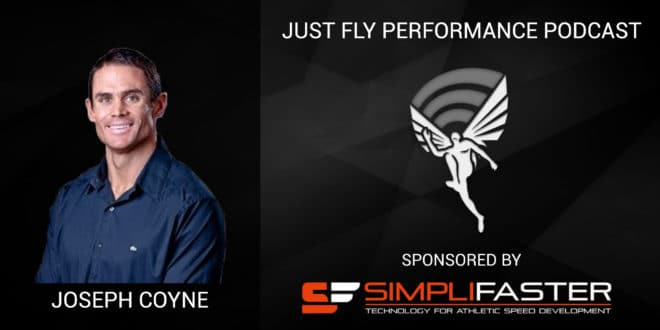Joseph Coyne is the Physical Preparation Coach with the Chinese Athletics Association. He joined the Just Fly Performance podcast for a wide-ranging and detailed discussion on training sprinters and jumpers, going back to his time working with Randy Huntington.
Towards the end of the show, the conversation turned to overspeed sprinting. Coyne talked about how he and Huntington structured overspeed sprinting within their training cycles, and how the 1080 Sprint allows coaches to transfer training theories of “peak power-weight” from the gym to the track…
We would start overspeed sprinting at 10% faster than they can run, something like that, at a certain weight. Then you try to keep the speed the same but decrease the weight that is pulling them so they adapt to running that fast at their own body weight. Just as an aside, that’s something we also do with power in the weight room. Find out where the peak power is at the “peak power weight,” then you try to create that same power at lighter and lighter weights. Because unfortunately you don’t get to run down the track or take off in a long jump with a barbell on your back to generate extra power! So you have to increase the acceleration and velocity component of that equation to increase power.
The quantification of overspeed – running faster than you can normally – is really important. You can do it with bands or pulleys but you don’t really know. You can set up timing gates but you set up timing gates every 10 meters, and you might have two meters that are faster than the other two meters. And there’s a safety aspect to it as well.
It’s not just a test, it’s embedded in our day-to-day training. It’s almost worthless to do a test once every six weeks or every four weeks. You want to embed everything you do into your training, and record your power numbers and your velocities, and you monitor it over time and make changes over time. Because otherwise you don’t get an accurate picture… I’m a big fan of not isolating testing but embedding it into the day-to-day training.
RELATED: Fusing training and testing with the 1080 Sprint at The Hockey Summit
The heaviest concentration that we used – or that Randy would use – was two resisted and one overspeed sprinting session in a seven-day microcycle. Sometimes we also alternated between 1080 Sprint on one of those days – something overspeed – then following up with acceleration with a sled to add in some variety. It’s a variation to that resistance.
One thing I really like to do is more of the sled-pulling and sled-sprinting at peak power-weight. There’s a really good argument for it, the J-B Morin and (Pierre) Samozino stuff. I think you have to be careful with injury considerations, like the Achilles and whatnot.
[av_button_big label=’Next post:’ description_pos=’below’ link=’manually,http://’ link_target=” icon_select=’no’ icon=’ue800′ font=’entypo-fontello’ custom_font=’#ffffff’ color=’theme-color’ custom_bg=’#444444′ color_hover=’theme-color-subtle’ custom_bg_hover=’#444444′ av_uid=’av-vgna0x’]
1080 Motion Summit: J-B Morin, Cameron Josse and Jon Bowskill lead the line
[/av_button_big]
But I think if you work at peak power-weight in the gym why shouldn’t you work at peak power-weight on the track? Then reducing it through the same strategy of keeping the same power numbers while the weight on the sled decreases.






























































